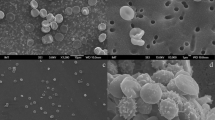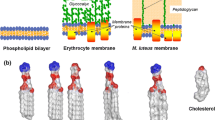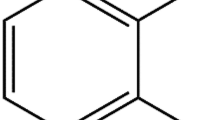Abstract
Native fullerene is notoriously insoluble in water and forms aggregates toxic to cell membranes, thus limiting its use in nanomedicine. In contrast, water-soluble fullerenol is compatible with biological systems and shows low in vivo toxicity on human cell lines. The interaction mechanism between these hydrophilic nanoparticles and biological membranes is however not well understood. Therefore, in this work, the effect of fullerenol on model eukaryotic and bacterial membranes was investigated using 31P- and 2H solid-state NMR as well as FTIR spectroscopy. DPPC/cholesterol and DPPC/DPPG bilayers were used to mimic eukaryotic and bacterial cell membranes, respectively. Our results show low affinity of fullerenol for DPPC/cholesterol bilayers but a clear interaction with model bacterial membranes. A preferential affinity of fullerenol for the anionic phospholipids DPPG in DPPC/DPPG membranes is also observed. Our data suggest that fullerenol remains at the water/bilayer interface of eukaryote-like membranes. They also indicate that the presence of a polar group such as DPPG’s hydroxyl moiety at the bilayer surface plays a key role in the interaction of fullerenol with membranes. Hydrogen bonding of fullerenol nanoparticles with DPPGs’ OH groups is most likely responsible for inducing lipid segregation in the lipid bilayer. Moreover, the location of the nanoparticles in the polar region of DPPG-rich regions appears to disturb the acyl chain packing and increase the membrane fluidity. The preferential interaction of fullerenol with lipids mostly found in bacterial membranes is of great interest for the design of new antibiotics.




Similar content being viewed by others
References
Aoshima H, Kokubo K, Shirakawa S, Ito M, Yamana S, Oshima T (2009) Antimicrobial activity of fullerenes and their hydroxylated derivatives. Biocontrol Sci 14(2):69–72
Bakry R, Vallant RM, Najam-ul-Haq M, Rainer M, Szabo Z, Huck CW, Bonn GK (2007) Medicinal applications of fullerenes. Int J Nanomed 2:639–649
Bensikaddour H, Snoussi K, Lins L, Van Bambeke F, Tulkens PM, Brasseur R, Goormatigh E, Mingeot-Leclercq MP (2008) Interactions of ciprofloxacin with DPPC and DPPG: fluorescence anisotropy, ATR-FTIR and 31P NMR spectroscopies and conformational analysis. Biochim Biophys Acta 1778:2535–2543
Bosi S, Da Ros T, Spalluto G, Prato M (2003) Fullerenes derivatives: an attractive tool for biological applications. Eur J Med Chem 38:913–923
Braun M, Hirsch A (2000) Fullerenes derivatives in bilayer membranes: an overview. Carbon 38:1565–1572
Casal HL, Mantsch HH (1984) Polymorphic phase behaviour of phospholipid membranes studied by infrared spectroscopy. Biochim Biophys Acta 779:381–401
D’Rozario R, Wee C, Wallace E, Sansom M (2009) The interaction of C60 and its derivatives with a lipid bilayer via molecular dynamics simulations. Nanotechnol 20:115102
Davis JH (1983) The description of membrane lipid conformation, order and dynamics by 2H-NMR. Biochim Biophys Acta 737:117–171
Endress E, Bayerl S, Prechtel K, Maier C, Merkel R, Bayerl T (2002) The effect of cholesterol, lanosterol, and ergosterol on lecithin bilayer mechanical properties at molecular and microscopic dimensions: a solid-state NMR and micropipet study. Langmuir 18:3293–3299
Epand RM, Vogel HJ (1999) Diversity of antimicrobial peptides and their mechanisms of action. Biochim Biophys Acta 1462:11–28
Goldfine H (1984) Bacterial membranes and lipid packing theory. J Lipid Res 25:1501–1507
Guo W, Hamilton J (1995) A multinuclear solid-state NMR study of phospholipid-cholesterol interactions. Dipalmitoylphosphatidylcholine-cholesterol binary system. Biochemistry 34:14174–14184
Hirsch A (2010) The era of carbon allotropes. Nature Mat 9:868–871
Kilfoil ML, Morrow MR (1998) Slow motions in bilayers containing anionic phospholipids. Phys A 261:82–94
Killian JA, Borle F, Kruijff B, Seelig J (1986) Comparative 2H- and 31P-NMR study on the properties of palmitoyllysophosphatidylcholine in bilayers with gramicidin, cholesterol and dipalmitoylphosphatidylcholine. Biochim Biophys Acta 854:133–142
Kroto H, Heath J, O’Brien S, Curl R, Smalley R (1985) C60: Buckminsterfullerene. Nature 318:162–163
Leroueil P, Hong S, Mecke A, Baker J, Orr B, Holl M (2007) Nanoparticle interaction with biological membranes: Does nanotechnology present a Janus face? Acc Chem Res 40:335–342
Mannock DA, Lewis R, McMullen T, McElhaney RN (2010) The effect of variations in phospholipid and sterol structure on the nature of lipid-sterol interactions in lipid bilayer model membranes. Chem Phys Lipids 163:403–448
Mantsch HH, McElhaney RN (1991) Phospholipid phase transitions in model and biological membranes as studied by infrared spectroscopy. Chem Phys Lipids 57:213–226
Marcotte I, Ouellet M, Auger M (2004) Insights on the interaction of met-enkephalin with negatively-charged membranes: an infrared and solid-state NMR spectroscopic study. Chem Phys Lipids 127:175–187
Mashino T, Okuda K, Hirota T, Hirobe M (1991) Inhibition of E. coli growth by fullerene derivatives and inhibition mechanism. Bioorg Med Chem Lett 9:2959–2962
Mateo-Alonso A, Tagmatarchis N, Prato M (2006) Fullerenes and their derivatives. In: Gogotsi Y (ed) Carbon Nanomaterial. Taylor & Francis, London, pp 1–39
McConnell H, Radhakrishnan A (2006) Theory of the deuterium NMR of sterol- phospholipid membranes. Proc Natl Acad Sci USA 103:1184–1189
Mendelsohn R, Mantsch HH (1986) Fourier transform infrared studies of lipid-protein interaction. In: Watts A, De Pont JJHHM (eds) Progress in protein-lipid interactions. Elsevier, Amsterdam, pp 103–146
Nakamura S, Mashino T (2009) Biological activities of water-soluble fullerene derivatives. J Phys: Conf Ser 159:012003
Nielsen GD, Roursgaard M, Jensen KA, Poulsen SS, Larsen ST (2008) In vivo biology and toxicology of fullerenes and their derivatives. Basic Clin Pharmacol Toxicol 103:197–208
Partha R, Conyers JL (2009) Biomedical applications of functionalized fullerene-based nanomaterials. Int J Nanomed 4:261–275
Picard F, Paquet MJ, Lévesque J, Bélanger A, Auger M (1999) 31P NMR first spectral moment study of the partial magnetic orientation of phospholipid membrane. Biophys J 77:888–902
Qiao R, Roberts AP, Mount AS, Klaine SJ, Ke PC (2007) Translocation of C60 and its derivatives across a lipid bilayer. Nano Lett 7:614–619
Sayes C, Fortner J, Guo W, Lyon D, Boyd A, Ausman K, Tao Y, Sitharaman B, Wilson L, Hughes J, West J, Colvin V (2004) The differential cytotoxicity of water-soluble fullerenes. Nano Lett 4:1881–1887
Seelig J (1977) Deuterium magnetic resonance: theory and application to lipid membranes. Q Rev Biophys 10:353–418
Seelig J (1978) 31P Nuclear magnetic resonance and the head group structure of phospholipids in membranes. Biochim Biophys Acta 515:105–140
Seelig J, Seelig A (1980) Lipid conformation in model membranes and biological membranes. Q Rev Biophys 13:19–61
Seydel JK (2002) Function, composition, and organization of membranes. In: Seydel JK, Wiese M (eds) Drug-membrane interactions: analysis, drug distribution and modeling. Wiley, Weinheim, pp 3–33
Smith ICP, Ekiel IH (1984) Phosphorus-31 NMR of phospholipids in membranes. In: Gorenstein DG (ed) Phosphorus-31 NMR: Principles and applications. Academic Press, London, pp 447–475
Spurlin T, Gewirth A (2007) Effects of C60 on solid supported lipid bilayers. Nano Lett 7:531–535
van Beek JD (2007) A flexible toolbox for processing, analysing and visualizing magnetic resonance data in Matlab®. J Magn Reson 187:19–26
Vincent JS, Revak SD, Cochrane CC, Levin IW (1993) Interactions of model human pulmonary surfactants with a mixed phospholipid bilayer assembly: Raman spectroscopic studies. Biochemistry 32:8228–8238
Vist MR, Davis JH (1990) Phase equilibria of cholesterol/dipalmitoylphosphatidylcholine mixtures: 2H nuclear magnetic resonance and differential scanning calorimetry. Biochemistry 29:451–464
Warschawsky DE, Arnold AA, Beaugrand M, Gravel A, Chartrand E, Marcotte I (2011) Choosing membrane mimetics for structural studies of transmembrane proteins. Biochim Biophys Acta 1808:1957–1974
Wilson SR (2002) Nanomedecine: Fullerene and carbon nanotube biology. In: Osawa E (ed) Perspectives of fullerene nanotechnology. Kluwer Academic Publishers, Great Britain, Part IV, pp 155–163
Zhang YP, Lewis RN, McElhaney RN (1997) Calorimetric and spectroscopic studies of the thermotropic phase behavior of the n-saturated 1,2-diacylphosphatidylglycerols. Biophys J 72:779–793
Acknowledgments
This work was supported by the Fonds de recherche du Québec—Nature et Technologies (FRQNT) and the Centre Québécois sur les Matériaux Fonctionnels (CQMF), as well as the Canadian Foundation for Innovation (CFI). P.P.B. is grateful to the Canadian Institutes of Health Research (CIHR) Strategic Training Initiative in Chemical Biology for the award of an MSc scholarship. The authors wish to thank P. Bazire and C. Bourgeois for technical assistance.
Author information
Authors and Affiliations
Corresponding author
Rights and permissions
About this article
Cite this article
Brisebois, P.P., Arnold, A.A., Chabre, Y.M. et al. Comparative study of the interaction of fullerenol nanoparticles with eukaryotic and bacterial model membranes using solid-state NMR and FTIR spectroscopy. Eur Biophys J 41, 535–544 (2012). https://doi.org/10.1007/s00249-012-0809-5
Received:
Revised:
Accepted:
Published:
Issue Date:
DOI: https://doi.org/10.1007/s00249-012-0809-5




